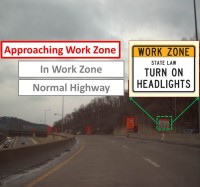
Identifying work zones is necessary if automobiles will someday drive autonomously on highways. Some work zones go on for miles with warning signs and changes to traffic patterns while others may be a single vehicle on the roadside with a few cones. Visual indication of work zones including signs, cones, barrels, and vehicles/equipment are widely diverse in the appearance. They can also appear in any combination: some places use cones, other barrels, and still others rectangular signs. There is also wide variation in within the classes of objects and signs used, with differences in materials, size, shape, visual design, and also wear, damage and obscuration. Methods of distinguishing and classifying construction zones must address this diversity. This project applies learning-based methods of detection and classification. We established methods that can distinguish highway lane boundaries under a wide variety of object and environmental conditions. The same underlying techniques are adapted to imagery of the road to detect signs of an approaching work zone. This evaluation can then be used to modify the behavior of autonomous vehicles.

